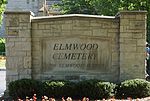Heidelberg Project
The Heidelberg Project is an outdoor art project in the McDougall-Hunt neighborhood on Detroit's east side, just north of the city's historically African-American Black Bottom area. It was created in 1986 by the artist Tyree Guyton, who was assisted by his wife, Karen, and grandfather Sam Mackey ("Grandpa Sam"). The Heidelberg Project is in part a political protest, as Tyree Guyton's childhood neighborhood began to deteriorate after the 1967 riots. Guyton described coming back to Heidelberg Street after serving in the Army; he was astonished to see that the surrounding neighborhood looked as if "a bomb went off".At first, the project consisted of him painting a series of houses on Detroit's Heidelberg Street with bright dots of many colors and attaching salvaged items to the houses. It was a constantly evolving work that transformed an inner-city neighborhood where people were afraid to walk, even in daytime, into one in which neighbors took pride and where visitors were many and welcomed. Despite the area being characterized by high levels of blight and poverty, the evolving art work grew, Tyree Guyton worked on the Heidelberg Project daily with the children on the block. He and director Jenenne Whitfield gave lectures and workshops on the project around the country. Their main goal was to develop the Heidelberg Project into the city's first indoor and outdoor museum, complete with an artists' colony, creative art center, community garden, amphitheater, and more. In 2005 the Heidelberg Project was awarded the Rudy Bruner Award for Urban Excellence silver medal.
Excerpt from the Wikipedia article Heidelberg Project (License: CC BY-SA 3.0, Authors).Heidelberg Project
Heidelberg Street, Detroit
Geographical coordinates (GPS) Address Website External links Nearby Places Show on map
Geographical coordinates (GPS)
| Latitude | Longitude |
|---|---|
| N 42.358675 ° | E -83.021355555556 ° |
Address
Heidelberg Project
Heidelberg Street 3600
48207 Detroit
Michigan, United States
Open on Google Maps









